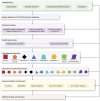Assessing the adherence of large language models to clinical practice guidelines in Chinese medicine: a content analysis
- PMID: 40786055
- PMCID: PMC12331602
- DOI: 10.3389/fphar.2025.1649041
Assessing the adherence of large language models to clinical practice guidelines in Chinese medicine: a content analysis
Abstract
Objective: Whether large language models (LLMs) can effectively facilitate CM knowledge acquisition remains uncertain. This study aims to assess the adherence of LLMs to Clinical Practice Guidelines (CPGs) in CM.
Methods: This cross-sectional study randomly selected ten CPGs in CM and constructed 150 questions across three categories: medication based on differential diagnosis (MDD), specific prescription consultation (SPC), and CM theory analysis (CTA). Eight LLMs (GPT-4o, Claude-3.5 Sonnet, Moonshot-v1, ChatGLM-4, DeepSeek-v3, DeepSeek-r1, Claude-4 sonnet, and Claude-4 sonnet thinking) were evaluated using both English and Chinese queries. The main evaluation metrics included accuracy, readability, and use of safety disclaimers.
Results: Overall, DeepSeek-v3 and DeepSeek-r1 demonstrated superior performance in both English (median 5.00, interquartile range (IQR) 4.00-5.00 vs. median 5.00, IQR 3.70-5.00) and Chinese (both median 5.00, IQR 4.30-5.00), significantly outperforming all other models. All models achieved significantly higher accuracy in Chinese versus English responses (all p < 0.05). Significant variations in accuracy were observed across the categories of questions, with MDD and SPC questions presenting more challenges than CTA questions. English responses had lower readability (mean flesch reading ease score 32.7) compared to Chinese responses. Moonshot-v1 provided the highest rate of safety disclaimers (98.7% English, 100% Chinese).
Conclusion: LLMs showed varying degrees of potential for acquiring CM knowledge. The performance of DeepSeek-v3 and DeepSeek-r1 is satisfactory. Optimizing LLMs to become effective tools for disseminating CM information is an important direction for future development.
Keywords: Chinese medicine; clinical practice guideline; comparison; knowledge acquisition; large language model.
Copyright © 2025 Zhao, Lai, Pan, Huang, Xia, Bai, Liu, Liu, Jin, Shang, Liu, Shi, Liu, Chen, Estill and Ge.
Conflict of interest statement
The authors declare that the research was conducted in the absence of any commercial or financial relationships that could be construed as a potential conflict of interest.
Figures




Similar articles
-
Performance of ChatGPT-4o and Four Open-Source Large Language Models in Generating Diagnoses Based on China's Rare Disease Catalog: Comparative Study.J Med Internet Res. 2025 Jun 18;27:e69929. doi: 10.2196/69929. J Med Internet Res. 2025. PMID: 40532199 Free PMC article.
-
Assessing the Role of Large Language Models Between ChatGPT and DeepSeek in Asthma Education for Bilingual Individuals: Comparative Study.JMIR Med Inform. 2025 Aug 13;13:e65365. doi: 10.2196/65365. JMIR Med Inform. 2025. PMID: 40802989 Free PMC article.
-
Diagnostic performance of newly developed large language models in critical illness cases: A comparative study.Int J Med Inform. 2025 Dec;204:106088. doi: 10.1016/j.ijmedinf.2025.106088. Epub 2025 Aug 23. Int J Med Inform. 2025. PMID: 40865411
-
Performance of ChatGPT Across Different Versions in Medical Licensing Examinations Worldwide: Systematic Review and Meta-Analysis.J Med Internet Res. 2024 Jul 25;26:e60807. doi: 10.2196/60807. J Med Internet Res. 2024. PMID: 39052324 Free PMC article.
-
Impact of residual disease as a prognostic factor for survival in women with advanced epithelial ovarian cancer after primary surgery.Cochrane Database Syst Rev. 2022 Sep 26;9(9):CD015048. doi: 10.1002/14651858.CD015048.pub2. Cochrane Database Syst Rev. 2022. PMID: 36161421 Free PMC article.
References
-
- Benjamini Y., Hochberg Y. (1995). Controlling the false discovery rate: a practical and powerful approach to multiple testing. J. R. Stat. Soc. Ser. B Methodol. 57, 289–300. 10.1111/j.2517-6161.1995.tb02031.x - DOI
LinkOut - more resources
Full Text Sources

